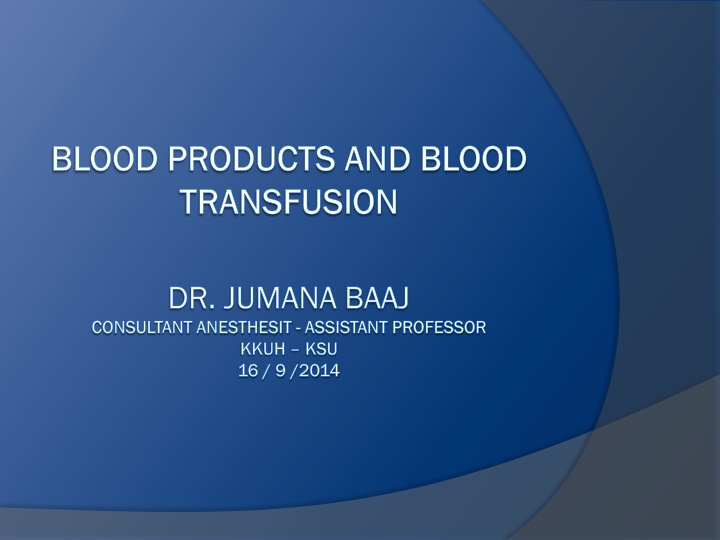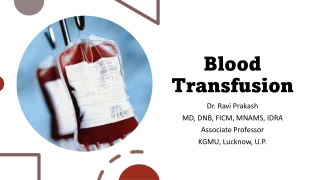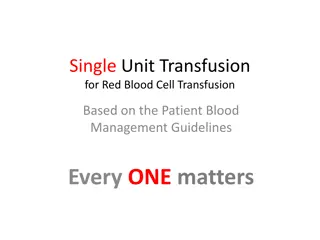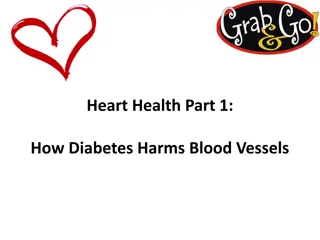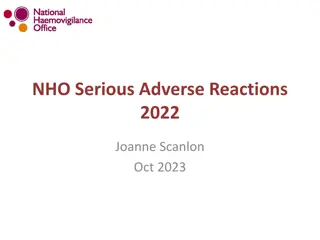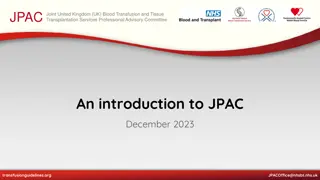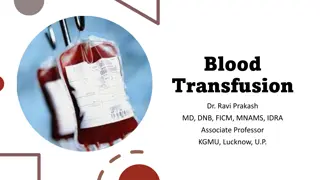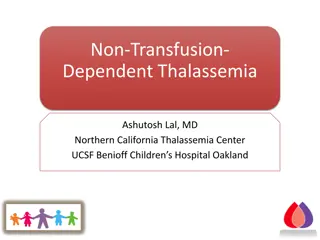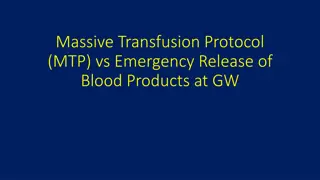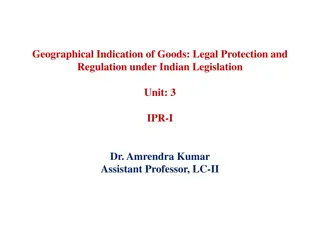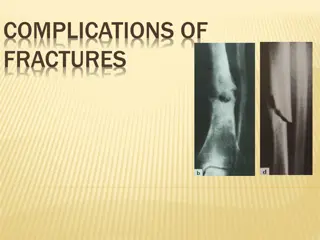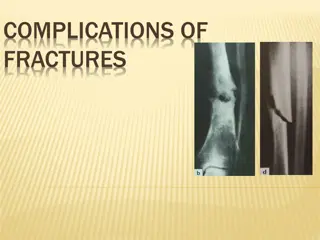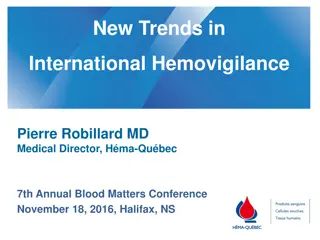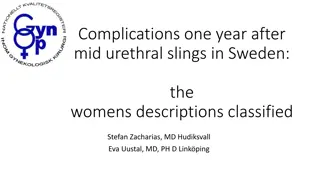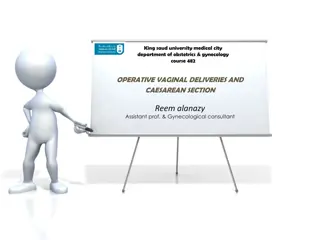Blood Transfusion: Indications, Complications, and Therapy
The diverse aspects of blood transfusion, including indications, blood components, complications, and alternative treatments. Learn about transfusion therapy, oxygen delivery, and when transfusion is necessary. Understand factors affecting oxygen carrying capacity and the role of hemoglobin in oxygen delivery. Discover the importance of transfusion triggers and tolerance of acute anemia in various clinical scenarios.
Download Presentation

Please find below an Image/Link to download the presentation.
The content on the website is provided AS IS for your information and personal use only. It may not be sold, licensed, or shared on other websites without obtaining consent from the author.If you encounter any issues during the download, it is possible that the publisher has removed the file from their server.
You are allowed to download the files provided on this website for personal or commercial use, subject to the condition that they are used lawfully. All files are the property of their respective owners.
The content on the website is provided AS IS for your information and personal use only. It may not be sold, licensed, or shared on other websites without obtaining consent from the author.
E N D
Presentation Transcript
BLOOD PRODUCTS AND BLOOD BLOOD PRODUCTS AND BLOOD TRANSFUSION TRANSFUSION DR. JUMANA BAAJ CONSULTANT ANESTHESIT CONSULTANT ANESTHESIT - - ASSISTANT PROFESSOR KKUH KKUH KSU 16 / 9 /2014 16 / 9 /2014 ASSISTANT PROFESSOR KSU
Objective Indication of blood transfusion Blood groups Blood component Blood transfusion complication treatment Alternatives to Blood Products
Transfusion Therapy Transfusion Therapy - 60% of transfusions occur perioperatively. - responsibility of transfusing perioperatively is the anesthesiologist.
Blood Transfusion Up to 30% of blood volume can be treated with crystalloids
When is Transfusion When is Transfusion Necessary? Necessary?
. . . TO . . . TO Increase oxygen carrying capacity Restoration of red cell mass Correction of bleeding induced by platelet dysfunction or thrombocytopenia Correction of bleeding induced by coagulation factors deficiencies
Oxygen Delivery Oxygen Delivery Oxygen Delivery (DO2) is the oxygen that is delivered to the tissues DO2= COP x CaO2 Cardiac Output (CO) = HR x SV Oxygen Content (CaO2): - (Hgb x 1.39)O2saturation + PaO2(0.003) - Hgb is the main determinant of oxygen content in the blood
Oxygen Delivery Oxygen Delivery (cont.) Therefore: DO2= HR x SV x CaO2 If HR or SV are unable to compensate, Hgb is the major deterimant factor in O2 delivery Healthy patients have excellent compensatory mechanisms and can tolerate Hgb levels of 7 gm/dL. Compromised patients may require Hgb levels above 10 gm/dL.
Transfusion Trigger: Hgb level at which transfusion should be given. - Varies with patients and procedures Tolerance of acute anemia depends on: - Maintenance of intravascular volume - Ability to increase cardiac output - Increases in 2,3-DPG to deliver more of the carried oxygen to tissues
Blood components Prepared from Whole blood collection Whole blood is separated by differential centrifugation
Differential Centrifugation First Centrifugation Closed System Whole Blood Main Bag Satellite Bag 1 Satellite Bag 2 First Platelet-rich Plasma RBC s
Differential Centrifugation Second Centrifugation Platelet- rich Plasma RBC s Second Platelet Concentrate Plasma RBC s
Antigen: a foreign substance that can elicit an immune (antibody) response. Antibodies specific immunoglobulin s produced in response to an antigenic challenge.
Two major antigen systems on the red blood cell are the ABO system and the Rhesus (Rh) system. Group A individuals have the A antigen present on their red blood cells. Group B individuals have the B antigen present on their red blood cells. Group AB individuals have antigens A and B present on their red blood cells. Group O have neither antigens A nor B present on their red blood cells
Normal healthy individuals make antibodies against the A and B antigen The antibodies are found in the individual s plasma and are referred to as naturally occurring. Group A individuals have anti B antibodies Group B individuals have anti A antibodies Group O individuals have anti A and anti B antibodies Group AB individuals have no antibodies
The Rh system encompasses multiple antigens. Rh (D) negative indicates that the Rh (D) antigen is not present on the red cell
Universal Blood Blood group O is considered the universal donor for red cells because it lacks the A and B antigen. Group O Rh negative can be considered for recipients of all blood groups. Blood group AB is considered the universal donor for platelets,
Blood Groups Incidence Blood Group A B AB O Rh Antigen on Plasma erythrocyte Antibodies White A Anti-B B Anti-A AB None Rh African- 40% 11 4 45 42 27% 20 4 49 17 None Anti-A Anti-B
Cross Match Cross Match Major: - Donor s erythrocytes incubated with recipients plasma Minor: - Donor s plasma incubated with recipients erythrocytes Agglutination: - Occurs if either is incompatible Type Specific: - Only ABO-Rh determined; chance of hemolytic reaction is 1:1000 with TS blood
Type and Screen Type and Screen Donated blood that has been tested for ABO/Rh antigens and screened for common antibodies (not mixed with recipient blood). - Used when usage of blood is unlikely, but needs to be available (hysterectomy). - Allows blood to available for other patients. - Chance of hemolytic reaction: 1:10,000.
Blood components packed red blood cells (PRBC s) platelet concentrate fresh frozen plasma (contains all clotting factors) cryoprecipitate (contains factors VIII and fibrinogen; used in Von Willebrand s disease) albumin plasma protein fraction leukocyte poor blood factor VIII antibody concentrates
Packed Red Blood Cells Packed Red Blood Cells 1 unit = 250 ml. Hct. = 70-80%. 1 unit pRBC s raises Hgb 1 gm/dL. Mixed with saline: LR (lactate ringer ) has Calcium which may cause clotting if mixed with PRBC s.
RBC Transfusions RBC Transfusions Administration Administration Dose Usual dose of 10 cc/kg infused over 2-4 hours Maximum dose 15-20 cc/kg can be given to hemodynamically stable patient Procedure May need Premedication (Tylenol and/or Benadryl) Filter use routinely leukodepleted Monitoring VS q 15 minutes, clinical status Do NOT mix with medications Complications Rapid infusion may result in Pulmonary edema Transfusion Reaction
Platelet Concentrate Platelet Concentrate Storage Up to 5 days at 20-24 Indications Thrombocytopenia, Plt <15,000 Bleeding and Plt <50,000 Invasive procedure and Plt <50,000 Considerations Contain Leukocytes and cytokines 1 unit/10 kg of body weight increases Plt count by 50,000 Donor and Recipient must be ABO identical
Plasma and FFP Contents Coagulation Factors (1 unit/ml) Storage FFP--12 months at 18 degrees or colder Indications Coagulation Factor deficiency, fibrinogen replacement, DIC, liver disease, exchange transfusion, massive transfusion Considerations Plasma should be recipient RBC, ABO compatible In children, should also be Rh compatible Usual dose is 20 cc/kg to raise coagulation factors approx 20%
Blood transfusion complication Blood transfusion complication Physical Circulatory overload Embolism (air, micro aggregate) Hypothermia Immunological Pyrogenic Type 1 hypersensitivity Graft versus host reactions Biochemical Acid base disturbances Hyperkalaemia Citrate toxicity Impaired oxygen release Infective Hemolytic transfusion reaction Disseminated intravascular coagulation
Acute Transfusion Reactions Acute Hemolytic Reactions (AHTR) Febrile Reactions (FNHTR) Allergic Reactions TRALI Coagulopathy with Massive transfusions Bacteremia
TRANSFUSION RELATED ACUTE LUNG INJURY
Complications of Blood Therapy Complications of Blood Therapy (cont.) Signs are easily masked by general anesthesia. - Free Hgb in plasma or urine - Acute renal failure - Disseminated Intravascular Coagulation (DIC)
Transmission of Viral Diseases: Human immunodeficiency virus (HIV) 22 day window for HIV infection and test detection Hepatitis virusis West Nile virus (WNV) Cytomegalovirus (CMV) Human T-cell lymphotrophic viruses (HTLVs) Parvovirus B19
Other Complications Other Complications - Decreased 2,3-DPG with storage: ? Significance - Citrate: metabolism to bicarbonate; Calcium binding - Microaggregates (platelets, leukocytes): micropore filters controversial - Hypothermia: warmers used to prevent - Coagulation disorders: massive transfusion (>10 units) may lead to dilution of platelets and factor V and VIII. - DIC: uncontrolled activation of coagulation system
Acute Hemolytic Reactions (AHTR) Tachycardia Hypotension Oozing from surgical sits Hemoglobin urea Renal shut down
Treatment of Acute Hemolytic Treatment of Acute Hemolytic Reactions Reactions Immediate discontinuation of blood products and send blood bags to lab. Support patients hemodynamic (fluid vasopressors) Maintenance of urine output with crystalloid infusions Administration of mannitol or Furosemide for diuretic effect
Massive blood transfusion Massive blood transfusion Blood volume formula Neonate - 90 ml/kg Infants 2 years ago - 80ml/kg Adult male - 70ml/kg Adult female - 60ml/kg
Massive blood transfusion Massive blood transfusion Defined one of three ways Acute administration of more than 1,5 times of estimated blood volume The replacement of patients blood volume by stored bank blood in less than 24 hours The acute administration of more than blood volume in less than 24 hours
Massive blood transfusion Massive blood transfusion Basic screening test after six-unit transfusion Hemoglobin and platelets count Coagulation profile ( Pt prothrompine time , activated partial thromboplastine time Plasma fibrinogen concentration Fibrin degradation products PH from arterial blood gas analysis Plasma Electrolyte
Massive blood transfusion Massive blood transfusion DIC Coagulopathy Citrate Toxicity Hypothermia metabolic alkalosis
Massive Blood Transfusion Coagulopathy due to dilutional thrombocytopenia. And dilution of the coagulation factors Citrate Toxicity does not occur in most normal patients unless the transfusion rate exceeds 1 U every 5 min or the patient has liver impairment Hypothermia Acid Base Balance The most consistent acid base abnormality after massive blood transfusion is postoperative metabolic alkalosis
Massive Blood Transfusion Serum Potassium Concentration The extracellular concentration of potassium in stored blood steadily increases with time. The amount of extra-cellular potassium transfused with each unit less than 4 mEq per unit. Hyperkalemia can develop regardless of the age of the blood when transfusion rates exceed 100 mL/min.
Massive blood transfusion Massive blood transfusion Diagnosis of DIC Increase APTT , PT , fibrin degradation product Decrease platelet count , fibrinogen concentration Treatment 4 units of FFP 6-8 units of platelets Cryoprecipitate if fibrinogen level less than 1 g/l PH less than 7,2 administrate 50 mmol bicarbonate Recombinant activated factor VIIa if bleeding continue in spite of use FFP platelets and cryoprecipatae
Alternatives to Blood Products Alternatives to Blood Products Autotransfusion Blood substitutes
Administering Blood and blood Administering Blood and blood Products Products - Consent necessary for elective transfusion - Unit is checked by 2 people for Unit #, patient ID, expiration date, physical appearance. - pRBC s are mixed with saline solution (not LR) - Products are warmed mechanically and given slowly if condition permits - Close observation of patient for signs of complications - If complications suspected, infusion discontinued, blood bank notified, proper steps taken.
Administering Blood Products Administering Blood Products - Consent necessary for elective transfusion - Unit is checked by 2 people for Unit #, patient ID, expiration date, physical appearance. - pRBC s are mixed with saline solution (not LR) - Products are warmed mechanically and given slowly if condition permits - Close observation of patient for signs of complications - If complications suspected, infusion discontinued, blood bank notified, proper steps taken.
What to do? If an AHTR occurs STOP TRANSFUSION ABC s Maintain IV access and run IVF (NS or LR) Monitor and maintain BP/pulse Give diuretic Obtain blood and urine for transfusion reaction workup Send remaining blood back to Blood Bank
Blood Bank Work-up of AHTR Check paperwork to assure no errors Check plasma for hemoglobin Repeat crossmatch Repeat Blood group typing Blood culture
Monitoring in AHTR Monitor patient clinical status and vital signs Monitor renal status (BUN, creatinine) Monitor coagulation status (DIC panel PT/PTT, fibrinogen, D-dimer/FDP, Plt, Antithrombin-III) Monitor for signs of hemolysis (LDH, bili, haptoglobin)
Auto Auto- -transfusion transfusion Techniques: Pre-deposit transfusion Intra-operative acute normovolemic hemodilution Intra-operative cell salvage
Pre Pre- -deposit transfusion deposit transfusion -blood collection begins 3-5 weeks preoperatively (2-4 units store) Eliminates risk of viral transmission Reduces risk of immunological reactions Collection is expensive and time consuming Only suitable for elective surgery
